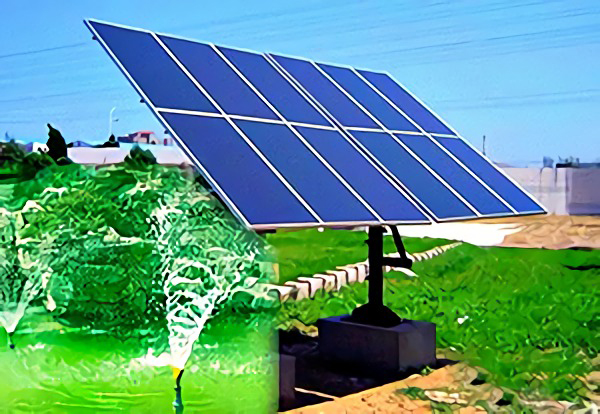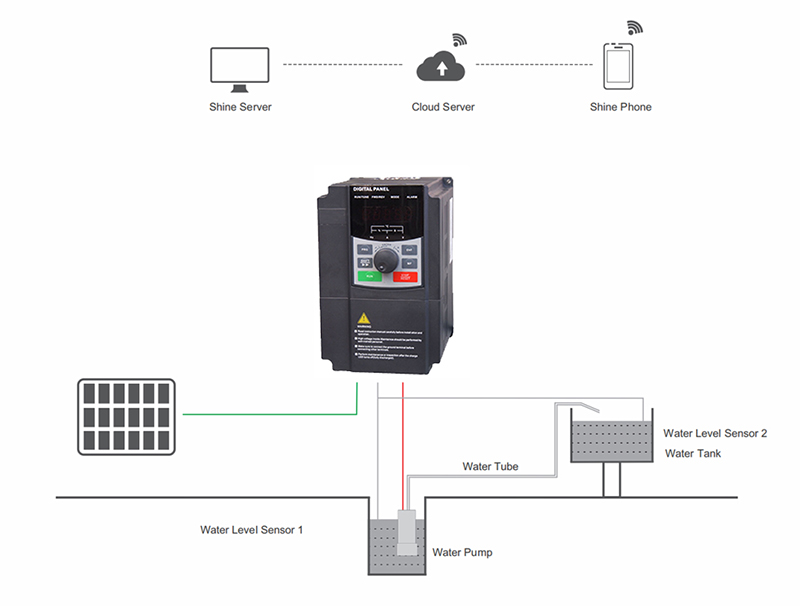A solar pump inverter is used to control and regulate the operation of a solar water pump system (PV pumping system). It can convert the DC from the solar array into AC to drive the water pump. In addition, it can adjust the output frequency in real-time according to the sunlight intensity to achieve maximum power point tracking (MPPT). Next, inverter.com will bring you the definition of a solar water pump inverter and its powerful function introduction.
Solar pump inverter basics
Solar pump inverters are one of the various types of power inverters. Its function is similar to the function of a common on-grid inverter. The two inverters are both used to convert solar DC into AC. But the solar pump inverter is greatly improved. Thus, it can greatly save system costs and expand the solar energy application range.
Solar pump inverter is an off-grid inverter. It does not rely on the power grid and can drive the load independently. However, the routine off-grid inverter can work only when it is equipped with a battery. However, the lead-acid battery price is very high, accounting for 30% of the total system cost. Besides, its service life is as short as 3-5 years, which will affect the system's investment income.

The solar pump inverter does not need a battery and can work as long as there is sunlight. What we need to do is to construct a water tower at a high place and we can take the water from this water tower any time we need it. The inverter itself will be installed with a water level control switch, which is very convenient. Its role is similar to the role of the battery in an off-grid system. But the water tower cost is much lower than the battery cost.
Function of solar pump inverter
DC to AC conversion: The current generated by solar photovoltaic panels is direct current (DC), while most home and commercial equipment and power grids use alternating current (AC). The main function of the solar pump inverter is to convert this DC into standard AC to meet the needs of the power network or equipment.
- Maximum Power Point Tracking (MPPT): The MPPT technology used in the inverter can ensure that the maximum power is extracted from the solar panels, thereby improving the efficiency of the entire solar system. This function helps the system achieve optimal performance under any given conditions.
- Power regulation and protection: The inverter also provides power regulation functions. Including voltage and frequency adjustment to ensure the stability and adaptability of the output current.
- Active operation and shutdown function: According to the intensity of solar radiation and the output power of the solar panel, the inverter can automatically start or stop working. The function of automatic startup at sunrise and automatic shutdown at sunset is realized.
- Power control function: Mainly adjust the power provided by solar energy, keep it at the maximum power task point, and ensure the normal operation of the system.
- Voltage adjustment function (for grid-connected system): The inverter can also adjust the output voltage to match the voltage of the grid, thereby ensuring a stable grid connection.
The solar pump inverter also has a variety of protection functions, such as current limiting, overload protection, short circuit protection, overvoltage protection, undervoltage protection, overcurrent protection, clean energy reverse flow protection, etc. These functions can ensure the stable operation of the system and protect electronic equipment from damage.
The reason why the function of solar water pump inverter is amazing
Why the function of a solar water pump inverter is so amazing? The explanation shall be started from the AC work principle. The AC includes three elements which are voltage, current, and frequency. Normally, the frequency is 50HZ. When the motor is started, it rotates 50 times per second. The power changes with the change of the current and voltage. Thus, the voltage and current are used to calculate the power. But the situation is different for the motor and its power is affected by the frequency.

Its rated power is the power calculated under the 50Hz frequency. When the frequency decreases, the power will decrease accordingly. The rated power of the motor =rated torque*rated rotation times. As long as the rated torque is not changed, the motor can work normally. Thus, when the frequency and voltage decrease, the rated power and rotation speed (frequency) will decrease proportionally.
